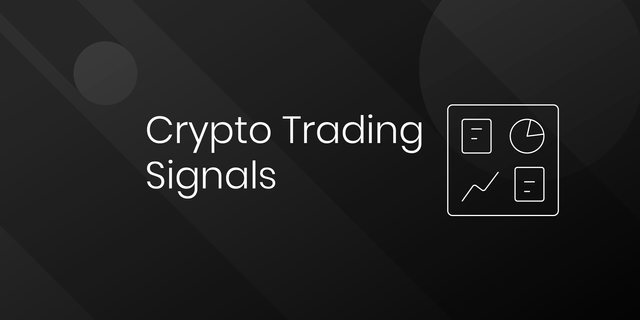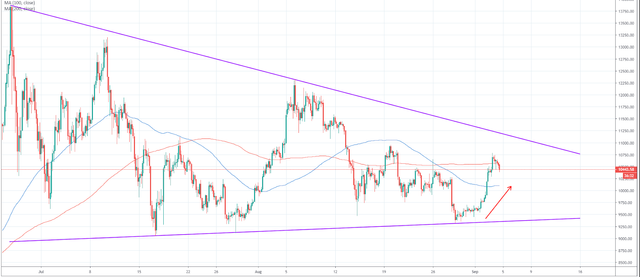Crypto Trading Signals

In a market that is as volatile as the cryptocurrency market, any piece of advice or a suggestion can prove to be valuable. This is why trading signals seem to be very popular with crypto traders, as they help mostly inexperienced traders to make profits in a volatile market.
Definition of crypto trading signals
Crypto trading signals are defined as a suggestion or advice to enter a trade, either buy or sell, generated by analysis. Any of the three main types of market analysis - technical, fundamental or sentiment - can generate a signal. However, those that have both fundamental and technical reasoning are usually the most efficient.
In addition, algorithms are programmed to issue signals based on certain technical indicators.
The ultimate goal of any tool or analysis is to generate a signal is to provide investors with an informed suggestion - whether it is to buy or sell crypto. All signals should have a precise entry, take profit and stop loss levels.
Similar to crypto trading bots, analysts believe that one of the major strengths of automatic trading bots generating trading signals is the non-existence of the psychological aspect of the trading process. Therefore, investors and traders are provided with a clearly technical advice, without bias towards any direction - devoid of all emotions.
How to generate crypto trading signals
There are different ways of generating a crypto trading signal. Unlike the stock market or forex, the crypto market is a relatively young trading market. So, many crypto traders do not possess the resources or experience to generate trading signals themselves. This is why we have a relatively large number of signal providers in the market today.
Automated trading bots, like Bitshares’ DEXBot, are one of the most popular generators of trading signals. They are all designed to recognize a specific chart pattern based on a set of indicators and either automatically open/close the trade on behalf of a trader, or send a trade signal to a trader, who will then make a final decision.
Influenced by social media networks, “copy” trading is becoming more and more popular, especially amongst younger trading generations. Certain platforms allow their users to replicate trades of the other users automatically. In essence, it works similarly to crypto trading bots as trades are automatically opened, after being generated by someone else than the trader himself.
Still, the most popular type of generating trading signals is by applying technical analysis. By analyzing the historical price action of a digital asset, traders use different indicators and tools to forecast future trends and find market opportunities.
Sparkdex charting tool offers a long list of available indicators, amongst which the most popular are the moving average, trend lines, volume, Fibonacci (retracement and extensions), as well as oscillators etc. Of course, all these indicators can be applied across different time frames.
Generating a crypto trading signal
Let’s apply the basic technical analysis in order to generate a trading signal.
We see a BTC/USD chart below, where we applied two basic indicators - two most popular moving averages (100 and 200) and trend lines connecting recent highs and lows.

BTC/USD signal generator
Since the symmetrical triangle (although not perfect) has been formed now, the price action converges, preparing for a break out in one of the two directions. On the upside, we connected at two lower highs, while on the downside we have two almost equal touches.
What happens next is that the price action touches the established trend lines on the downside, finds support and strongly rebounds higher. So, the basic technical analysis has generated a trading signal.
In this case, the crypto trading signal would be: Buy against the trend line, in the region of $9,300 - $9,350, as the price sometimes doesn’t exactly touch the line. Any move and close below, let’s say $9,200, invalidates this signal, meaning we are closing our trade in red. On the other hand, we are looking for a bounce to at least the first resistance, which in this case is the 100 MA.
Once the signal has been generated by our analysis, we entered a long BTC trade at $9,350 and ultimately closed it around $10,050, just below the 100 MA.
The trading signal provided us with an opportunity to earn 700 pips by risking only 150 pips.
The aim of crypto trading signals
In a young and relatively inexperienced trading market, many traders rely on crypto trading bots and signal providers to feed them suggestions and trade ideas. On the other hand, those with more market-related experience will use their own resources and any of the three available types of market analysis to generate signals themselves.
Whether you use a bot, a signal provider, copy ideas and trades from another trader, or generate ideas yourself, the aim of the signals is the same - provide investors with an informed advice as whether to buy or sell particular digital asset.
Download the Official Bitspark App:
iOS Version: http://ow.ly/KNuF50wAfpT
Android Version: http://ow.ly/83pe50wAfpU
To listen to the audio version of this article click on the play image.

Brought to you by @tts. If you find it useful please consider upvoting this reply.